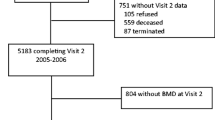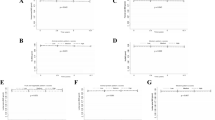Abstract
Summary
We investigated the association between nutrient patterns and risk of fractures in 1,482 older subjects. Patterns associated with higher intakes of Ca, P, vitamin B12, proteins and unsaturated fats, and moderate alcohol intake, provided by diets rich in dairies and charcuteries, were related to a lower risk of wrist and hip fractures.
Introduction
The purpose of this study was to investigate the relationship between patterns of nutrient intake and the risk of fractures in older subjects.
Methods
Among 1,482 participants from the Bordeaux sample of the Three-City (3C) Study who completed a 24-h dietary recall and a food frequency questionnaire, we examined the association between patterns of nutrient intake derived from principal component analysis and 8-year incidence of self-reported fractures of the hip, the wrist, and the vertebrae.
Results
A “nutrient-dense” pattern rich in Ca and P, iron, vitamins B including B12, vitamins C and E, alcohol, proteins, and unsaturated fats, and characterized by a higher consumption of fruits and vegetables, meats and fish, cheese and milk, charcuteries, cereals, rice, pasta, and potatoes, was associated with a 19 % (95 % CI 2–34 %, P = 0.03) lower risk of wrist fractures. The same pattern was associated with a 14 % (95 % CI 2–25 %) lower risk of fractures at any site. A “south-western French” pattern rich in Ca, P, vitamins D and B12, retinol, alcohol, proteins, and fats-including unsaturated fats; poor in vitamins C, E, and K, carotenes, folates, and fibers; and related to a higher consumption of cheese, milk, and charcuterie and a lower consumption of fruits and vegetables was related to a 33 % lower risk of hip fractures (95 % CI 3–39 %, P = 0.03).
Conclusions
Higher intakes of Ca, P, vitamin B12, proteins, and unsaturated fats and moderate alcohol, provided by dietary patterns rich in cheese, milk, and charcuteries, were related to a lower risk of wrist and hip fractures in our cohort.
Similar content being viewed by others
References
Cummings SR, Melton LJ (2002) Epidemiology and outcomes of osteoporotic fractures. Lancet 359:1761–1767
Rachner TD, Khosla S, Hofbauer LC (2011) Osteoporosis: now and the future. Lancet 377:1276–1287
Burge R, Dawson-Hughes B, Solomon DH, Wong JB, King A, Tosteson A (2007) Incidence and economic burden of osteoporosis-related fractures in the United States, 2005–2025. J Bone Miner Res 22:465–475
Cheng SY, Levy AR, Lefaivre KA, Guy P, Kuramoto L, Sobolev B (2011) Geographic trends in incidence of hip fractures: a comprehensive literature review. Osteoporos Int 22:2575–2586
The DIPART (vitamin D Individual Patient Analysis of Randomized Trials) group (2010) Patient level pooled analysis of 68 500 patients from seven major vitamin D fracture trials in US and Europe. BMJ 340:b5463
Chung M, Lee J, Terasawa T, Lau J, Trikalinos TA (2011) Vitamin D with or without calcium supplementation for prevention of cancer and fractures: an updated meta-analysis for the U.S. Preventive Services Task Force. Ann Intern Med 155:827–838
Committee to review dietary reference intakes for vitamin D and calcium, (2010) Dietary reference intakes for calcium and vitamin D. Institute of Medicine, Washington
Darling AL, Millward DJ, Torgerson DJ, Hewitt CE, Lanham-New SA (2009) Dietary protein and bone health: a systematic review and meta-analysis. Am J Clin Nutr 90:1674–1692
Cashman KD (2007) Diet, nutrition, and bone health. J Nutr 137:2507S–2512S
Sahni S, Cupples LA, McLean RR, Tucker KL, Broe KE, Kiel DP, Hannan MT (2010) Protective effect of high protein and calcium intake on the risk of hip fracture in the Framingham offspring cohort. J Bone Miner Res 25:2770–2776
Three-City Study Group (2003) Vascular Risk factors and risk of dementia: design of the Three-City Study and baseline characteristics of the study population. Neuroepidemiology 22:316–325
Favier J, Ireland-Ripert J, Toque C, Feinberg M (1995) Répertoire Général des Aliments. Table de Composition, 2nd edn. INRA Editions, Paris
Souci S, Fachman W, Kraut H (2000) Food composition and nutrition tables. Medpharm Scientific, Stuttgart
Feart C, Jutand MA, Larrieu S, Letenneur L, Delcourt C, Combe N, Barberger-Gateau P (2007) Energy, macronutrient and fatty acid intake of French elderly community dwellers and association with socio-demographic characteristics: data from the Bordeaux sample of the Three-City Study. Br J Nutr 98:1046–1057
Samieri C, Jutand MA, Feart C, Capuron L, Letenneur L, Barberger-Gateau P (2008) Dietary patterns derived by hybrid clustering method in older people: association with cognition, mood, and self-rated health. J Am Diet Assoc 108:1461–1471
Simermann J, Barberger-Gateau P, Beer C (2007) Validation of a food frequency questionnaire in older population. 25th Annual Congress of SFNEP: clinical nutrition and metabolism S69–70. Montpellier (France)
World Health Organization–World Health Organizing Collaborating Centre for Drug Statistics Methodology (2000) Guidelines for ATC classification and DDD assignment. WHO, Oslo
Moeller SM, Reedy J, Millen AE, Dixon LB, Newby PK, Tucker KL, Krebs-Smith SM, Guenther PM (2007) Dietary patterns: challenges and opportunities in dietary patterns research an Experimental Biology workshop, April 1, 2006. J Am Diet Assoc 107:1233–1239
Willett WC, Howe GR, Kushi LH (1997) Adjustment for total energy intake in epidemiologic studies. Am J Clin Nutr 65:1220S–1228S, discussion 1229S-1231S
Van Buuren S, Oudshoorn CGM (2000) Multivariate imputation by chained equations: MICE V1.0 User’s Manual. TNO Report PG/VGZ/00.038
Desquilbet L, Mariotti F (2010) Dose–response analyses using restricted cubic spline functions in public health research. Stat Med 29:1037–1057
Heaney RP, Layman DK (2008) Amount and type of protein influences bone health. Am J Clin Nutr 87:1567S–1570S
Dawson-Hughes B (2003) Interaction of dietary calcium and protein in bone health in humans. J Nutr 133:852S–854S
Ilich JZ, Brownbill RA, Tamborini L (2003) Bone and nutrition in elderly women: protein, energy, and calcium as main determinants of bone mineral density. Eur J Clin Nutr 57:554–565
Kruger MC, Coetzee M, Haag M, Weiler H (2010) Long-chain polyunsaturated fatty acids: selected mechanisms of action on bone. Prog Lipid Res 49:438–449
Orchard TS, Cauley JA, Frank GC et al (2010) Fatty acid consumption and risk of fracture in the Women’s Health Initiative. Am J Clin Nutr 92:1452–1460
Farina EK, Kiel DP, Roubenoff R, Schaefer EJ, Cupples LA, Tucker KL (2011) Protective effects of fish intake and interactive effects of long-chain polyunsaturated fatty acid intakes on hip bone mineral density in older adults: the Framingham Osteoporosis Study. Am J Clin Nutr 93:1142–1151
Virtanen JK, Mozaffarian D, Cauley JA, Mukamal KJ, Robbins J, Siscovick DS (2010) Fish consumption, bone mineral density, and risk of hip fracture among older adults: the cardiovascular health study. J Bone Miner Res 25:1972–1979
Tucker KL (2009) Osteoporosis prevention and nutrition. Curr Osteoporos Rep 7:111–117
Martin A (2001) The “apports nutritionnels conseilles (ANC)” for the French population. Reprod Nutr Dev 41:119–128
Lin PH, Ginty F, Appel LJ, Aickin M, Bohannon A, Garnero P, Barclay D, Svetkey LP (2003) The DASH diet and sodium reduction improve markers of bone turnover and calcium metabolism in adults. J Nutr 133:3130–3136
McTiernan A, Wactawski-Wende J, Wu L, Rodabough RJ, Watts NB, Tylavsky F, Freeman R, Hendrix S, Jackson R (2009) Low-fat, increased fruit, vegetable, and grain dietary pattern, fractures, and bone mineral density: the Women’s Health Initiative Dietary Modification Trial. Am J Clin Nutr 89:1864–1876
Bischoff-Ferrari HA (2011) The role of falls in fracture prediction. Curr Osteoporos Rep 9:116–121
Weiss LA, Barrett-Connor E, von Muhlen D (2005) Ratio of n-6 to n-3 fatty acids and bone mineral density in older adults: the Rancho Bernardo Study. Am J Clin Nutr 81:934–938
Smith GI, Atherton P, Reeds DN, Mohammed BS, Rankin D, Rennie MJ, Mittendorfer B (2011) Dietary omega-3 fatty acid supplementation increases the rate of muscle protein synthesis in older adults: a randomized controlled trial. Am J Clin Nutr 93:402–412
McNaughton SA, Wattanapenpaiboon N, Wark JD, Nowson CA (2011) An energy-dense, nutrient-poor dietary pattern is inversely associated with bone health in women. J Nutr 141:1516–1523
Okubo H, Sasaki S, Horiguchi H, Oguma E, Miyamoto K, Hosoi Y, Kim MK, Kayama F (2006) Dietary patterns associated with bone mineral density in premenopausal Japanese farmwomen. Am J Clin Nutr 83:1185–1192
Tucker KL, Chen H, Hannan MT, Cupples LA, Wilson PW, Felson D, Kiel DP (2002) Bone mineral density and dietary patterns in older adults: the Framingham Osteoporosis Study. Am J Clin Nutr 76:245–252
Hardcastle AC, Aucott L, Fraser WD, Reid DM, Macdonald HM (2011) Dietary patterns, bone resorption and bone mineral density in early post-menopausal Scottish women. Eur J Clin Nutr 65:378–385
Fairweather-Tait SJ, Skinner J, Guile GR, Cassidy A, Spector TD, Macgregor AJ (2011) Diet and bone mineral density study in postmenopausal women from the TwinsUK registry shows a negative association with a traditional English dietary pattern and a positive association with wine. Am J Clin Nutr 94:1371–1375
Langsetmo L, Hanley DA, Prior JC, Barr SI, Anastassiades T, Towheed T, Goltzman D, Morin S, Poliquin S, Kreiger N (2011) Dietary patterns and incident low-trauma fractures in postmenopausal women and men aged ≥ 50 y: a population-based cohort study. Am J Clin Nutr 93:192–199
Monma Y, Niu K, Iwasaki K et al (2010) Dietary patterns associated with fall-related fracture in elderly Japanese: a population based prospective study. BMC Geriatr 10:31
Willett W (1998) Nutritional epidemiology, 2nd edn. Oxford University Press, New York
Source of funding
The Three-City Study is conducted under a partnership agreement between the Institut National de la Santé et de la Recherche Médicale (INSERM), the Institut de Santé Publique et Développement of the Bordeaux Segalen 2 University, and Sanofi-Aventis. The Fondation pour la Recherche Médicale funded the preparation and initiation of the study. The 3C Study is also supported by the Caisse Nationale Maladie des Travailleurs Salariés, Direction Générale de la Santé, Mutuelle Générale de l’Education Nationale, Institut de la Longévité, Regional Governments of Aquitaine and Bourgogne, Fondation de France, and Ministry of Research–INSERM Programme “Cohortes et collections de données biologiques.” This work was carried out with the financial support of the “ANR–Agence Nationale de la Recherche—The French National Research Agency” under the “Programme National de Recherche en Alimentation et nutrition humaine,” project “COGINUT ANR-06-PNRA-005.” This specific analysis within the 3C study was funded by a research agreement between the INSERM and Danone Research.
Conflicts of interest
C. Samieri, V. Ginder Coupez, S. Lorrain, and B. Allès report no conflict of interest. C. Féart received fees for conferences from Danone. L. Letenneur received research support from Danone. V. Ginder and D. Paineau are members of Danone Research. Dr. Barberger-Gateau served on a scientific advisory board for Caisse Nationale pour la Solidarite et l’Autonomie, has received funding for travel and speaker honoraria from Lesier, Bausch & Lomb, Aprifel, Danone Institute, Canadian Association of Gerontology, and the Jean Mayer Human Nutrition Research Center on Aging, Tufts University, serves on the editorial boards of Disability and Rehabilitation, has received consultancy fees from Vifor Pharma, and receives research support from Lesieur, Danone, Agence Nationale de la Recherche, Conseil Régional d’Aquitaine, Institut Carnot LISA, and Groupe Lipides et Nutrition.
Author information
Authors and Affiliations
Corresponding author
Electronic supplementary material
Below is the link to the electronic supplementary material.
ESM 1
(PDF 71 kb)
Rights and permissions
About this article
Cite this article
Samieri, C., Ginder Coupez, V., Lorrain, S. et al. Nutrient patterns and risk of fracture in older subjects: results from the Three-City Study. Osteoporos Int 24, 1295–1305 (2013). https://doi.org/10.1007/s00198-012-2132-5
Received:
Accepted:
Published:
Issue Date:
DOI: https://doi.org/10.1007/s00198-012-2132-5




